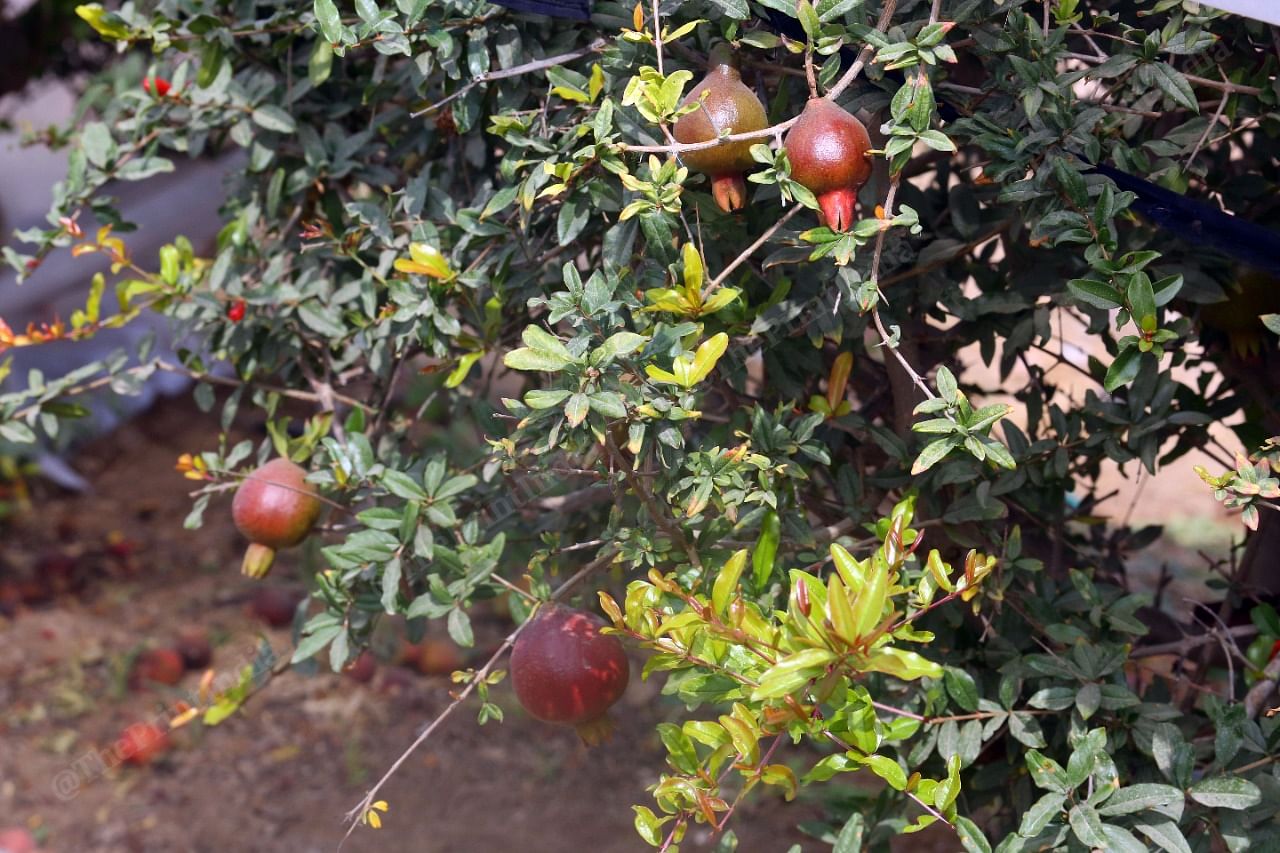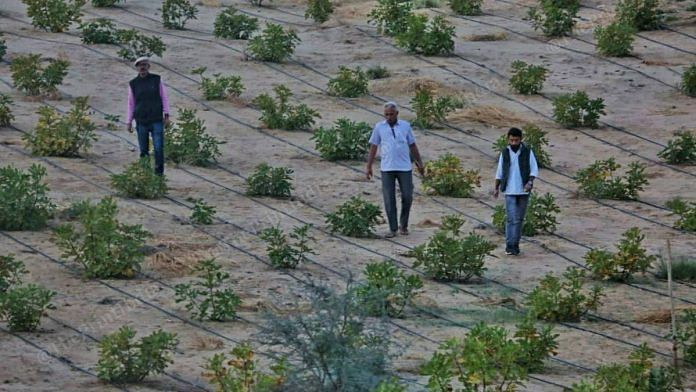Barmer: Lush fields of vegetables or orchards of fruit can hardly be associated with Rajasthan’s Barmer district, which lies in the Thar desert on the border with Pakistan.
Arid weather and brackish groundwater had for centuries decided the nature of the crops grown here — mostly bajra, chana and cumin, crops that are amenable to local desert conditions.
But, in recent years, agricultural science has helped farmers script a turnaround in Barmer, leading many to shift to cultivating fruits like pomegranates, dates and figs, and vegetables like tomato, brinjal, chilli and radish.
Not just this, pisciculture has made a stealthy approach too, and several farmers have taken up rearing sea fish as well as other large varieties like rohu and carp.
This magical transformation has happened through outreach by the Krishi Vigyan Kendra (KVK), a project under the National Agricultural Research Centre.
Agricultural scientists from KVK have helped Barmer to diversify its crops, and many farmers are reaping the gains — up to five times the amount of profit when compared to growing traditional crops.
Scientists from KVK visit farmers, check the pH level (a measure of how acidic water is) of groundwater, analyse the soil, and then recommend the type of crop suitable for them.
For ages, the primary challenge for farmers in Barmer was scanty rainfall and salty groundwater that are unsuitable for farming.
While in some areas, there is still no irrigation available for farmers, leaving them to rely heavily on patchy rainfall and thus growing only bajra and chana for sustenance, in others, farmers are now growing pomegranates and dates (since 2010), figs, and vegetables (started in the last two-three years).
Several farmers who grow the new crops have installed RO (reverse osmosis) systems, while some others in areas with good water have taken recourse to drip irrigation. However, currently, these are only limited to affluent farmers with large holdings.
Along with plants, scientists are also experimenting with rearing crustaceans such as lobsters and prawns (jheenga), as well as freshwater rohu and carp (katla) in the desert environment to diversify the income of villagers.
Also read: Hunger deaths to ‘rice bowl’: How Odisha’s Kalahandi-Balangir-Koraput corridor turned a corner
Colour of pomegranates
Pomegranates were introduced in the district in 2010. So far, the crop has proven to be the most profitable for farmers. Currently, the fruit is grown on 10,000 hectares in the district, and farmers report 10 times the profit by growing the fruit as compared to traditional crops such as cumin and bajra.
One such farmer who has benefited from growing pomegranates is Ganpat Singh of Radwa village. He currently has 8,000 pomegranate plants in his 28-acre farm.
“Earlier, I grew only cumin and bajra but earned absolutely no profit. Half my income would be the cost of production. But pomegranates have proven to be very useful. Krishi Vigyan Kendra helps me grow them organically, so my crop is of export quality and gets me a good price,” Singh told ThePrint. He added that while his yearly income as a cumin farmer was Rs 2-3 lakh, with pomegranates, it has shot up to Rs 9-10 lakh.
Farmers are reporting such profits because pomegranates yield two-three times more profit per hectare than cumin, said B.R. Morhwal, who works in the horticulture department of the KVK.
However, the plant does present some problems. “Pomegranate fruit starts developing cracks, and is infested with nematode (roundworms) if the temperature is too high and water too salty,” Morhwal explained.
Dr Vinay Kumar, head scientist at Krishi Vigyan Kendra, said that to battle the problem of fruit cracking, the district has started focusing on Bhagwa — a much smaller variety of pomegranate.

Another problem is that the fruit doesn’t fetch a good price in the district itself. Morhwal said this can be resolved through better marketing.
“Since pomegranate is grown in bulk, farmers suffer a loss in price realisation unless the crop is of export quality. Secondary businesses need to come up, like a factory for anardana powder (a flavoured delicacy), wine, juice… something. If such factories come up, the fruit being sold for Rs 100 for five kg will get farmers Rs 80-90 a kg,” Morhwal said.
Fish in the Thar
Since brackish water is a ground reality in Barmer, the district has started experimenting with aquaculture and even rearing sea fish, said Kumar.
“In a pond owned by KVK, we laid the eggs of jheenga, rohu, katla, and the experiment was successful. In three years, the bigger fish have grown to be five kilograms each,” he added.
Currently, only four farmers in the remote border villages of Rohida and Boi have started rearing marine creatures in their ponds. However, so far, they have experimented only with jheenga.
“What happens in Barmer is farmers invest in a tubewell and get disappointed when the groundwater turns out to be salty and unsuitable for farming. So, we’re now encouraging them to build a pond under the state’s Khet Talab Yojna, and grow seafish in the salty water,” Kumar said.
The fish farmers of Rohida and Boi sell the fresh fish to the Border Security Force (BSF) and in turn earn decent profits, added Kumar.
The experiment with pisciculture in Barmer, however, is currently in its nascent stage.
Dates and figs
After pomegranates, dates are the most popular fruit cultivated in Barmer — grown in 400 hectares across the district.
But the maturity of the fruit coincides with the rains (it spoils the quality) and the tree takes three-five years to bear fruits — two attributes that make it less popular than pomegranates.
“Around 157 date palms are planted in a hectare, while approximately 887 pomegranate trees can be planted in the same area. So, farmers don’t prefer growing date palms. However, it’s gaining traction, and has been grown in 400 hectares,” Morhwal said.
Figs were introduced in the area just two years ago. According to KVK figures, it’s already grown in 400-500 hectares, but they’re not sure of the number of farmers growing the fruit in collaboration with private companies.
“We try to tell farmers to buy the plant from us at Rs 80 a plant, but private firms provide more assistance and promise better rates, so some of them tie up with them,” Morhwal said.
One such farmer is Gida Road village’s Maga Ram. “The government has never contacted me in any way,” he said. Ram started growing figs about a year back and bought them from a private company at Rs 340 a plant. He’s hopeful about the future.
“Since the lockdown, cumin prices have crashed in the market. They have fallen to Rs 115 a kg from Rs 250 a kg. It earns me nothing, and is a high-risk crop that gets damaged easily. So I’ve put my bets on figs, let’s see how they work out for me,” he added.
Although date palm has been grown in the bordering district of Jaisalmer, it was introduced in Barmer just about a decade ago, Morhwal added.
Figs were never traditionally grown here, but since the arid conditions are suitable for its cultivation, the state decided to experiment with it one-two years ago and the results have been favourable, Kumar said.
Brinjals and tomatoes
Another silent farm revolution in Barmer is the growing of vegetables. Where there was little cultivation even two years ago, vegetables like brinjal, tomato, chilli, and radish, are now being grown in the district.
“A small village called Shivkar was the only place in Barmer with vegetable cultivation,” said Morhwal. “Now, we look at the pH level and analyse the land (soil) of the farmer and recommend to them what vegetables to grow. In two years, it has been so successful that Barmer is now self-sustainable when it comes to vegetables. Earlier, everything was brought here from neighbouring Gujarat,” he added.
(Edited by Saikat Niyogi)
Also read: Liberate Indian soil from chemical fertilisers, PM Modi says at natural farming conclave



